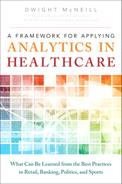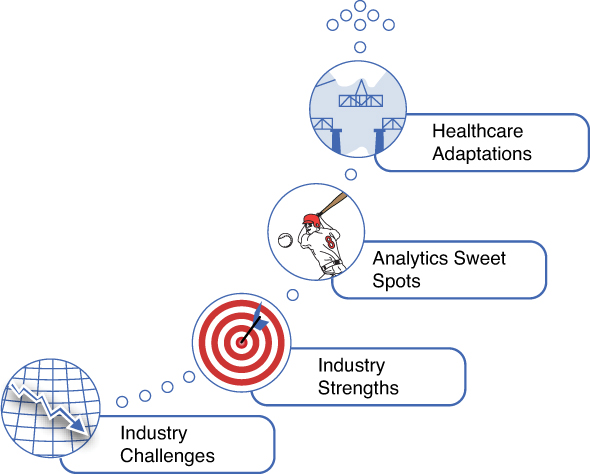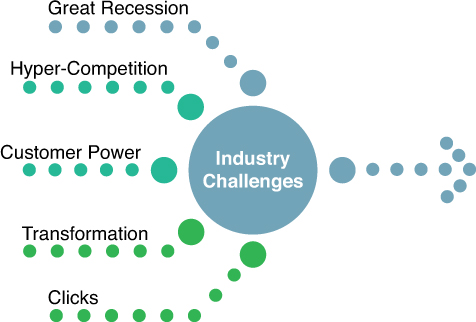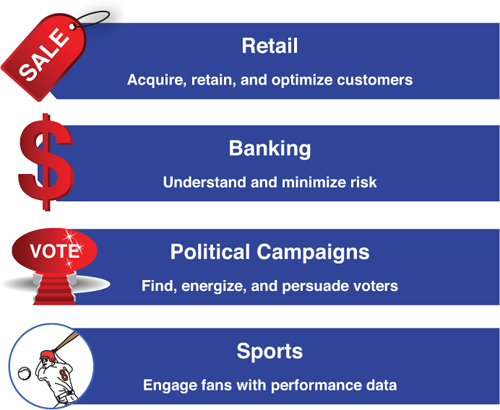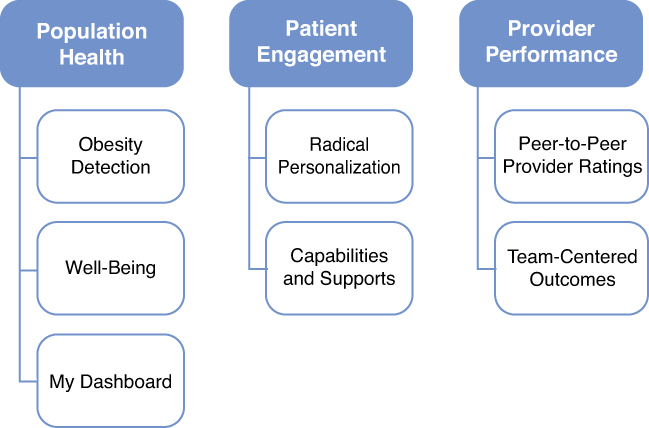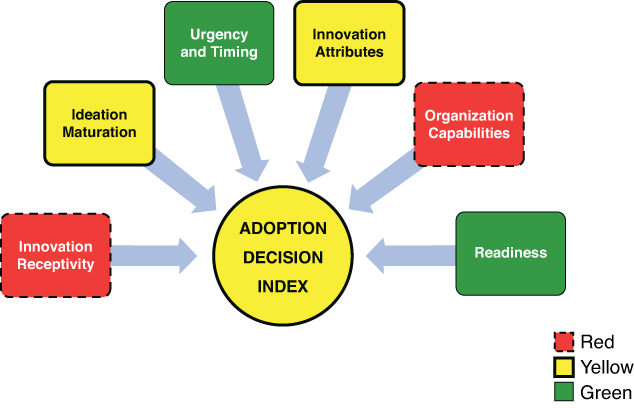1. Overview
This book is about discovering ideas in faraway places and building bridges to welcome them home.
Introduction
Ideas matter. They are the seeds from which innovations grow. Innovating to achieve competitive differentiation is the top business challenge today. And analytics is the high-octane fuel to power innovations to achieve business breakthroughs.
The premise of this book is that healthcare can learn a lot from other industries. Industries develop deep and unique strengths in certain areas and get very proficient in the associated analytics. Other industries that do not experience the same set of forces do not develop these analytics capabilities. They are blinded from them and their potential performance is constrained. This book provides a guided tour of industries that are somewhat mysterious to healthcare, including retail, banking, politics, and sports. The express purpose is to harvest some ideas and build a bridge to adapt them in healthcare. Indeed, the best analytics from these industries provide insights to address some of the most intractable challenges in healthcare.
The book is divided into three parts. The first part is the discovery process to harvest analytics sweet spots from the four industries. The second part is the distillation and interpretation of the sweet spots into the most compelling healthcare analytics adaptations. The third part provides a roadmap for putting ideas into action and a model to evaluate the adoptability of the healthcare adaptations.
Analytics Innovations
Analytics in healthcare is a paradox. On the one hand, healthcare is immersed in analytics. It is far ahead of other industries in using science, for example, to understand diseases and develop new cures and treatments. But the translation of the science into practice has been disappointingly incomplete. U.S. healthcare faces major challenges, not the least of which are its low standing in the world on key health outcomes, efficiency, cost, disparities, and affordability. And research shows that the odds of getting the right medical service are just a bit higher than 50/50.1 In a word, the science has just not been put into clinical or business practice sufficiently.
The fact is that we know how to address these challenges, and analytics can be a tremendous support; but there’s a blockage. This is due to a number of factors, including the seemingly overarching prerequisite to digitize the business before anything else can be harvested from analytics. This forestalls other forms of analytics that can lead to real benefits for business today. But it is more complicated than that. There is an amalgam of contributing barriers, including the lack of good coordination among actors in the ecosystem, a perverse payment system that does not reward value, complex products and services, ambiguity about who the customer is, professional autonomy, convoluted market dynamics, multiple vested and powerful interests, and a pervasive, risk-averse culture.
In spite of these challenges, the field must innovate to make change happen. Innovation is critical to the success of any business. A recent MIT survey of 3,000 executives across many industries and countries found that the top business challenge is “innovating to achieve competitive differentiation.”2 This was far ahead of the usual business challenges to grow revenue and reduce costs. Innovation rises to the top at this time because the Great Recession required businesses to address all possibilities for cost reduction, and many have developed very lean organizations. Businesses recognize that they need to grow the top line, and not just by extending the old line. And to grow the top line, they have to transform the business.
This is especially true in healthcare. For example, health insurers face commodity prices for premiums, the demand for transparency, and a flip of the business model from business-to-business to business-to-consumer, among other pressures related to healthcare reform. Similarly, providers are facing market and government pressures to improve outcomes, lower waste, and change the underlying revenue model from fee-for-service to global payments. In response, the leading companies are dramatically changing their identities. For example, some health insurers are becoming health companies, and others are viewing claims processing as one of many product lines as they become information companies. The industry archetypes are eroding and innovation is charting a new path.
Innovation is tricky. It is a necessary but a high-risk/high-reward strategy. Companies that do not take the risk can set themselves up for a death spiral. And those that do take the risk need to overcome many challenges, not the least of which is the complexity and unpredictability of implementing innovations. Few innovations succeed. Even with good execution, the innovation might be too early or too late relative to market demand and competitor actions. Or it might prove to be too weak to produce a worthwhile benefit relative to the cost. But for those that do succeed, it can be a game changer and propel the company to new heights.
Innovation starts with creativity. Creativity, whether in art or science, involves looking at things in new and different ways that result in fresh ideas that others regard as beautiful or useful or both. It involves breaking out of established patterns and connecting and rearranging current knowledge. Steve Jobs said that “creativity is just connecting things” like one’s experience and knowledge and then “synthesizing new things.”3 There are many methods for generating new ideas, including taking on a different role, for example, of a patient in healthcare, combining ideas from different disciplines, or challenging current paradigms. And, of course, businesses in one industry can learn from businesses in another. Paul Plsek, an expert on complexity and “directed creativity,” says that “when we open up our thinking to receive ‘fresh knowledge’ from outside the healthcare system about customer flow, we may notice the concepts of drive-through windows in the fast food industry, or Internet-based services in banking. This fresh knowledge might feed a creative generation process that results in ideas about how drive-through windows and Internet sites might be used to serve patients in a new primary care clinic.”4
Ideas begin a process that can ultimately lead to innovations that can make a positive impact on people’s lives and the bottom line. Success depends on the wisdom of the idea, the translation of the idea into a design and related strategy to carry it out, excellence in implementing it, and eventually reinventing it.
Ideas can come from comfortable places and unfamiliar places. This book concentrates on the latter, not because they are better, but because they are often ignored. They are ignored because they do not necessarily fit our beliefs about how the world works. We tend to seek out information that confirms our positions and ignore the rest, what is referred to as confirmation bias. So outside-in thinking has an inherent hurdle at the outset. But ignoring outside-in thinking can lead to blind spots. For example, there are legions of dedicated professionals that concentrate on the problems within healthcare with the intent to improve them. The blind spot of this process might be characterized this way: “Removing the faults in a stage-coach may produce a perfect stage-coach, but it is unlikely to produce the first motor car.”5
When the healthcare industry has looked to other industries for ideas and solutions and subsequently adapted these to healthcare, it has often produced impressive results. For example, quality improvement leaders like Don Berwick from the Institute for Healthcare Improvement and Brent James from Intermountain Healthcare have provoked and worked relentlessly to inspire and educate the field to use process control methods from other industries including the teachings of Deming and methods like six-sigma. And they have demonstrated significant improvements. The frustration has been the slow spread of the innovations that have been proven to be so effective.
Another need for creativity, derived from connecting knowledge from other industries, is to prevent a “Kodak moment.” Perhaps you remember the old Kodak moments. These were absolutely beautiful photographs derived from Kodak film products that were published in magazines like LIFE decades ago. But the new Kodak moment of 2012 is a not-so-pretty picture of the company filing for bankruptcy. The bankruptcy was due in part to the disruptive technologies of the digital camera and later of smartphones that upended the company’s value proposition about its film products. Both digital technologies took good pictures, virtually eliminated cost, and ended the inconvenience of waiting for the pictures to be developed. The other reason for the bankruptcy was that Kodak thought its products were perfect and did not see or subsequently adapt to the threat. However, a competitor in the film business, Fuji, did adapt and thrived. It rethought the use of the chemicals used in the film production business and discovered that they were rich in antioxidants, which are the mainstay of facial makeup products, and it went into the business. There are three issues pertinent to creativity: (1) the need for organizational receptivity to new ideas, (2) the ever-present danger of game-changing, new technology that can make an existing product or business obsolete, and (3) the need to adapt through innovation.
Are there Kodak moments looming for healthcare, and might these be knowable through the sensing of developments in other industries? Of course! And especially in the area of analytics. These are described throughout the book, but here is a glimpse of what’s to come:
• Democratization of data, which results in the availability of new data from public “open government” databases and from private “data snatchers”
• Change in the locus of power of data due to mobile technologies and social media
• Deep reliance on predictive modeling to address behavior change
• Allegiance to the customer
Each of these insights could lead to ideas that might flower into innovations, which in turn could result in breakthroughs for business success.
Discovery of Healthcare Adaptations
The premise of the book is that healthcare can and should learn from the best analytics of other industries. Certain ideas will lead to adaptable innovations in healthcare. The process for discovering ideas from other industries used in the book is depicted in Figure 1.1. Note that this approach is based on the firmly held belief that analytics succeeds when it responds to the needs of the business and not when analytics answers—that is, technologies and methodologies—are in search of business questions.
Industry Challenges
The first stage in the discovery process is industry challenges. This stage seeks to understand the industry, goals, context, challenges, and drivers. These ingredients mix together in a crucible that determines how an industry needs to perform to succeed by developing and honing areas of strength. For example, the banking industry suffered a disastrous plunge in trust and revenues due to its irresponsible subprime mortgage lending practices. This not only contributed to the Great Recession, which cut demand for its products, but also led to onerous regulations and oversight that constrained the business, especially in the area of lending. It subsequently developed greater strengths in risk assessment.
The industry challenges are unique to each industry and are detailed in the chapters to follow. There are challenges common to all the industries reviewed in the book, and these are included in Figure 1.2. Note that these industry challenges do not include the generic business challenges, such as increasing revenues, reducing costs, improving the balance sheet, paying attention to customers, and so forth. Rather, these challenges reflect specific game-changing events and trends that portend new waves of threats and opportunities.
The first challenge was the Great Recession. This was not a typical, cyclical recession. In fact, it was the worst economic period since the Great Depression. It shattered customer purchasing power and the demand for products and services.
The second challenge is hyper-competition. This is partly related to the Great Recession and the need to capture dwindling purchasing dollars. But it is also an endpoint of the convergence of the cross-industry challenges described later. Hyper-competition makes demands on analytics to gather and analyze more diverse and larger volumes of data to know the customer more fully. This is most evident in the retail industry, where personal data can help predict what a customer wants to buy before the purchase. Hyper-competition is also evident in political campaigns. The overarching need to find and sway a small number of voters who could spell victory or defeat required a new winning strategy in the 2012 U.S. Presidential election. The winning strategy was to be extremely data driven.
The third challenge is customer power. Customers are taking the upper hand in their relationships with business because they have the data at their fingertips, in their smartphones and tablets, and they use it to make more informed purchasing decisions. The whole process of buying has been accelerated, yet made more deliberate, because of the availability of price information from multiple sellers on the Internet. Similarly, customers want to do business with companies “their way,” on their preferred devices, with access to services 24/7, and expect the business to provide flawless service across channels. Finally, customers want information that makes sense to them and on their terms, which is often obtained from peers and not from marketing departments or government agencies.
The fourth challenge is the need for transformation. There is no sitting still and the race continues to have no finish line. But the difference is that the very nature of the business has to evolve and the pace of change is accelerating. The tried-and-true ways of succeeding in banking, retail, healthcare, and even sports are up for grabs. The need for transformation creates the appetite for innovation.
The final challenge is clicks. Clicks are the sounds of doing business on computing devices. Clicks are challenging the bricks. What could be more indicative of shifting paradigms than the collapse of the structures in which people do business (bricks)? Mobile “rules” for now because it is seemingly a new organ of the body that offers new functionality, is integrated perfectly, and is appreciated. It is almost like a seventh sense for humans. Mobile will give way to the next generation of new (artificial) body parts for sensing and communicating, perhaps as Google Glass eyewear. But the point has been made. Digital devices that provide more human functionality in ways that are “natural” and improve people’s capability to sense are game changers.
Industry Strengths
The second stage of the discovery process is the understanding of industry strengths. All industries have unique strengths that, if exploited, can drive business breakthroughs to beat the competition. The unique industry strengths identified in the discovery process and distilled to their essence are summarized in Figure 1.3 and described in the following list.
• For retail, it is clear that the overarching strength of the industry is to acquire, retain, and optimize customers. Marketing’s customer analytics are woven into this strength.
• For banking, the unique industry strength is understanding and minimizing risk. As mentioned earlier, the industry needed to clean up its lending practices for its very survival. Risk assessment has always been a core element of the industry, but it needed to get a lot better to reduce loan defaults without crimping the volume of loans. This became an industry imperative that necessitated the refinement of the industry strength.
• The industry strength of political campaigns is the laser focus on finding, energizing, and persuading voters. This strength was made more powerful through data-driven innovations.
• Finally, sports has a very unique strength in its ability to engage fans through the full transparency of detailed performance data on its athletes and teams. Athletes are acquired, fired, and improved based on the data. The paradox for healthcare is that sports fans know much more about the athletes who entertain them than patients do about the doctors who make life-and-death decisions about them.
Analytics Sweet Spots
The third stage of the discovery process is identifying the analytics sweet spots that correspond to the industry strengths. The concept of a sweet spot comes from sports. It is the place where a combination of factors results in the maximum impact achieved relative to a given amount of effort. In baseball, for example, it is that place on the bat that produces the most powerful hit. The analogue in analytics is a solution that provides the most power to make the industry strength as successful as possible. In the case of banking, the analytic sweet spot, matched to the industry strength, is a refined FICO score that assesses the capability of a borrower to fulfill promises to repay a loan.
What we have learned is that each industry pushes the envelope in its use of specific analytics, not necessarily because it has more technical sophistication, but because the specific goals, purposes, pressures, and culture of that industry are unique and require better flowering of certain analytic tools. These are the sweet spots that we want to translate and adapt for healthcare.
There are cross-industry analytics themes that shape the manifestation of advanced analytics generally and have a strong influence on the analytics sweet spots for each industry, as highlighted in Figure 1.4.
Modeling Behavior Change
Predictive modeling to change behavior is a powerful, advanced analytics method used across the industries. Predictive modeling is commonly used for general business purposes, including forecasting, simulation, root cause analysis, and data mining. Most of the breakthrough applications of predictive modeling across industries in this book focus on understanding and changing behaviors of customers. Examples include the following:
• Retail: Determine the probability that a woman is pregnant and her estimated delivery date.
• Banking: Determine the likelihood of divorce as a major predictor of loan default.
• Political campaigns: Determine the messages most likely to convert an undecided voter.
• Sports: Determine what attributes of players contribute to team wins.
It’s the Customer, Stupid
It goes without saying that customers are what make businesses thrive or die. Businesses can be distracted and focus on other priorities but do so at their peril. The industries in this book espouse that the pathway to growth is realized by understanding customers and responding in ways to earn their business. The analytics combo of predictive modeling with “boundless personal data” allows unprecedented views into what makes customers tick.
Boundless Personal Data
We live in a surveillance society. There is a huge business and government appetite to know everything about us. For example:
• Retail: “If you use a credit card or a coupon, or fill out a survey, or mail in a refund, or call the customer help line, or open an e-mail we’ve sent you or visit our Web site, we’ll record it and link it to your Guest ID...and we can buy data about you...(such as) charitable giving and cars you own.”6
• Politics: “The campaigns spent over $13 million on acquisition of data like whether voters may have visited pornography Web sites, have homes in foreclosure, are more prone to drink Michelob Ultra than Corona or have gay friends or enjoy expensive vacations.”7
• Military: The National Counterterrorism Center can use any information the government has collected on you, including “flight records, lists of Americans hosting foreign-exchange students, financial records of people seeking federally backed mortgages, health records of patients at veterans’ hospitals...this obscure agency has permission to study [any database] for patterns....”8
Most of the industries reviewed are using boundless personal data to feed their customer analytics engines. The new data usually come from outside the industry including “open” public databases, data “snatchers,” and Web click trackers. A growing industry of data aggregators sell the data and solutions related to it. The large increase in the diversity and volume of personal data, in combination with other analytics methods such as predictive modeling and technology game changers, has been a significant factor in solving business problems and demonstrating the value of analytics across industries.
Big Data Promises
The promise of big data is great and alluring. McKinsey & Company proclaims that “it will become the basis of competition, underpinning new waves of productivity growth, innovation, and consumer surplus.”9 Boundless personal data, as described previously, is a piece of it. But big data goes beyond that and looks to extract meaning from every digital signal that is emitted. It is very likely that harnessing big data will lead to a new world neural system that can measure almost anything. For example, we are told that the technology is nearly there to monitor the heartbeat of every living human being on the planet. But it appears that the technology “hows” are ahead of the business “whys” and “whats.” It is unknown how this revolution, like the Internet revolution before it, is going to play out and address business needs. But it is clear that the big promises will take a long time to keep. Lots of research needs to get done, and many hypotheses need to be developed, in order for big data to produce big business results.
Technology Game Changers
Technology advances facilitate the use of data for analytics. Three game changers have been influential:
1. Clicks: The Internet has transformed the way businesses communicate, market, do commerce with customers, and collect data about them. One example is the ability to do randomized trials, or A/B testing, of alternative Web site features—for example, how to get the most contributions during a political campaign—on large samples and virtually instantaneously.
2. Mobile: Earlier we described the challenges and opportunities of mobile. It is seen as the preferred platform for customer communications across industries.
3. Hadoop: Hadoop is an open source software framework that allows for the distributed processing of large data sets across clusters of computers using a simple programming model. It is less expensive and easier to get up and running than commercial applications; for example, it is cloud based and works across hardware. It has greatly facilitated the analysis of boundless data.
Looming Privacy Concerns
As boundless personal data increases the utility of analytics to address business needs, it also runs the risk that the “creepy factor” will stop it dead in its tracks. Most of these data are collected and used without the consent of the individual. For example, personal data is collected from children as they traverse the Internet and then used for tailoring marketing messages to them. This concern about privacy is acknowledged but largely ignored, and the response is often to deny its existence. For example, one large technology firm said that “nobody’s sitting around sifting through data on an individual basis and intentionally targeting specific individuals.” And political campaigns have said that they are not “indiscriminately scooping up personal data on potential supporters.” The facts would suggest otherwise. The data are very valuable and, while the gate is open, there are few restrictions on its use. But a few breaches of privacy might bring on a spate of consumer complaints and Congressional action.
Sociology, Not Technology
All the analytics sweet spots across the industries are successful because they complement and support important business needs and strengths. Excellent analytics methods can be developed in a bubble outside the realities of the business. But unless they are used to solve business problems, they collect dust and are an expense and not an investment. Making things happen/change/succeed is what business is about. It’s not about the technology; it’s the sociology. What is clear from the analytics sweet spots is that the bull’s-eye for the value proposition for analytics is understanding business challenges and strengths and providing tools and expertise in the right way and at the right time to support the business.
Analytics Adaptations
The final stage in the discovery process is the translation of industry analytics sweet spots into potential adaptations in healthcare. It is hard to imagine, on the face of it, how banking is anything like healthcare. The task involves connecting dots between the industries to arrive at some revelation. It involves some logic, but is mostly about creativity. Creativity often leads to an epiphany.
The logical approach might proceed as follows: Both banking and healthcare were hit at about the same time with industry-shaking regulations for reform. And both possess a bountiful number of transactions. Indeed, banking is far ahead of healthcare in transactions processing efficiency, what with its pioneering innovations in self-service (ATMs) and its heavier regulatory compliance pressures. So one might infer that if banking does transactions better, the processes that support it should be considered for adoption by healthcare. It is certainly worth exploring, and we do so in the banking chapter, but it does not make the cut as a recommended adaptation. Replicating processes is not enough. We are looking for a sweet spot that is unique, addresses outcomes, and has a plausible bridge to addressing important concerns in healthcare as an adaptation.
Mostly, what translation requires is a creative leap. In the banking case, and reflecting on the industry strength in risk assessment, one ponders what it is about assessing customer capabilities and risks that might apply in healthcare. What is it? What emerged is that one of the most ingrained and intractable issues in healthcare is getting people to be active co-producers of their own health and thereby improve outcomes. People’s behavior is the biggest influencer of health functioning followed by many social determinants. Can the risks, capabilities, and barriers to the fulfillment of doctor’s orders, prescriptions, and plans that rest with the individual be measured and then managed better? This healthcare adaptation, called the Health Improvement Capability Score (HICS), is one of the seven adaptations that are distilled from the discovery process in the industry chapters of the book.
The seven healthcare analytics adaptations are listed in Figure 1.5 and are described in detail in Chapter 7, “The Top Healthcare Analytics Adaptations.” The seven analytics adaptations cluster into three important areas of health and healthcare, including population health, patient engagement, and provider performance. The figure shows how each of the adaptations maps to the clusters. The adaptations for population health include obesity detection, well-being, and my dashboard. For patient engagement, the adaptations include radical personalization, and capabilities and support. Provider performance includes the adaptations of peer-to-peer provider ratings and team-centered outcomes.
Putting Ideas into Action
We do not just leave the ideas hanging. Certainly, it is important to generate ideas and to show the way across the bridge to healthcare. But it is better to be a good steward and give the ideas their best shot to be put into action. A goal of the book is to provide a framework for the adoption of health analytics.
Ideas are fragile. Eggers and O’Leary think of ideas as seeds. Harkening back to a biblical parable, they note: “Some seeds land on rocky soil. Others are eaten by birds, and some sprout only to be choked by thorns. Only through a fortuitous combination of sun, soil, and water will a seed grow into a plant and bear fruit.”10 And progressing ideas to the endpoint of making a real difference is a long journey, and not all ideas deserve the passage.
The last chapter of this book provides a framework and tools for progressing an innovation from its early beginnings as an idea to the successful implementation of it into the operations of an organization. The Innovation Pathway (see Figure 1.6) depicts the six stages of this journey.
We then concentrate on the adoption of innovations and propose an Innovation Adoption Factors Model (see Figure 1.7), which describes the six areas or domains that need to be considered and mastered in order to persuade individuals to make the decision to adopt an innovation. The Model is composed of two halves. On the left side is the idea stage and on the right is the design stage. The idea stage includes the domains of innovation receptivity, ideation maturation, and urgency/timing. The design stage includes the domains of the innovation’s attributes, the organization’s capabilities, and the readiness to position the innovation for adoption.
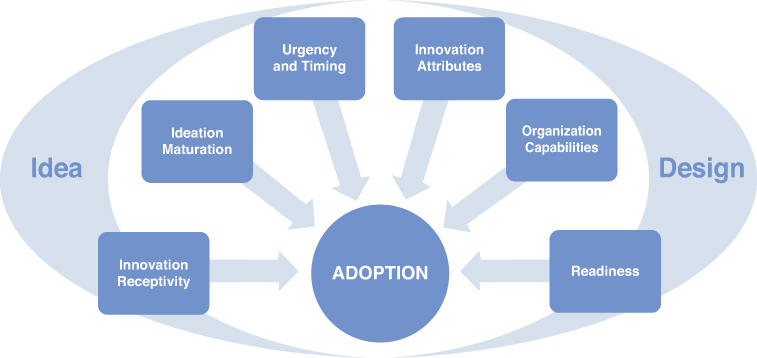
Adapted from Rogers on diffusion theory,11 Eggers and O’Leary on getting things done in government,12 Kingdon on agenda setting,13 Hasenfeld and Brock on policy implementation,14 Pressman and Wildavsky on program implementation,15 Gladwell on the tipping point model of change,16 and Plsek17 and Stacey18 on complexity theory.
Figure 1.7 Innovation Adopters Factors Model.
We then break down the six domains into 18 factors and describe each of them. (See Figures 1.8 and 1.9 for a summary.) The factors become the basis for a guidebook that can be used for evaluation and planning for an innovation adoption.
The final chapter concludes with an application of the model to one of the healthcare adaptations proposed in this book, in the Health Improvement Capability Score, through a case study. The hypothetical health plan evaluated the 18 factors of the model and summarized the results in the Adoption Decision Dashboard (see Figure 1.10).
The evaluation yielded a “yellow” rating on the overall adoption decision index. A postscript reviews how the innovation was adopted after six months of hard work to bring the index to “green” and convince the executive committee to decide in its favor.
